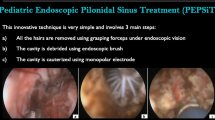Abstract
Since its first description in 1883, different treatments for pilonidal sinus disease have been proposed, but we are still far from the identification of an ideal approach. The objective of this study is to determine if video-assisted ablation of pilonidal sinus (VAAPS) could be considered superior/non-inferior to standard sinusectomy for treatment of pilonidal sinus disease. After applying propensity score analysis, data from 40 patients who underwent sinusectomy and 40 patients who underwent VAAPS, from March 2011 to August 2013, were collected. The two groups were similar in terms of sex, age, BMI, smoking status and complexity of sinus. The mean operative time was less for the sinusectomy group compared with the minimally invasive treatment group (30.38 ± 6.23 vs 44.39 ± 7.76; p = 0.001). On the other hand, the recurrence rate (7.5% vs 25%; p = 0.035) was significantly lower in the VAAPS group and the infection rate showed a trend toward reduction in the endoscopically treated patients (12.5% vs 30%; p = 0.057). No differences were found in terms of pain score at 1 week from surgery (3.71 ± 1.24 vs 3.76 ± 1.39; p = 0.883), satisfaction at 6 months (8.3 ± 1.2 vs 8.2 ± 1.3; p = 0.78) and time off work (2.01 ± 1.30 vs 2.08 ± 1.24; p = 0.620). The effectiveness of our new technique can be assessed again and the comparative analysis with the conventional sinusectomy shows the feasibility of VAAPS, suggesting that this procedure is the best way to perform a sinusectomy.






Similar content being viewed by others
References
Chintapatla S, Safarani N, Kumar S, Haboubi N (2003) Sacrococcygeal pilonidal sinus: historical review, pathological insight and surgical options. Tech Coloproctol 7:3–8
Hull TL, Wu J (2002) Pilonidal disease. Surg Clin N Am 82(6):1169–1185
Milone M, Sosa Fernandez LM, Musella M, Milone F (2016) Safety and efficacy of minimally invasive video-assisted ablation of pilonidal sinus a randomized clinical trial. JAMA Surg 151(6):547–553
Soll C, Hahnloser D, Dindo D, Clavien PA, Hetzer F (2008) A novel approach for treatment of sacrococcygeal pilonidal sinus: less is more. Int J Colorectal Dis 23(2):177–180
Milone M, Musella M, Di Spiezio Sardo A et al (2014) Video-assisted ablation of pilonidal sinus: a new minimally invasive treatment: a pilot study. Surgery 155(3):562–566
Enriquez-Navascues JM, Emparanza JI, Alkorta M, Placer C (2014) Meta-analysis of randomized controlled trials comparing different techniques with primary closure for chronic pilonidal sinus. Tech Coloproctol 18(10):863–872
Emile SH, Elfeki H, Shalaby M, Sakr A, Giaccaglia V, Sileri P, Wexner SD (2018) Endoscopic pilonidal sinus treatment: a systematic review and meta-analysis. Surg Endosc. https://doi.org/10.1007/s00464-018-6157-5
Bascom J (1983) Pilonidal disease: long-term results of follicle removal. Dis Colon Rectum 26:800–807
Meinero P, Mori L, Gasloli G (2014) Endoscopic pilonidal sinus treatment (E.P.Si.T.). Tech Coloproctol 18:389–392
Doll D (2010) 5- and 10-year recurrence rate is the new gold standard in pilonidal sinus surgery benchmarking. Med Princ Pract 19(3):216–217
Doll D, Matevossian E, Luedi MM (2015) Does full wound rupture following median pilonidal closure alter long-term recurrence rate? Med Princ Pract 24(6):571e7
Milone M, Velotti N, Manigrasso M, Anoldo P, Milone F, De Palma GD (2018) Long-term follow-up for pilonidal sinus surgery: a review of literature with metanalysis. Surgeon. https://doi.org/10.1016/j.surge.2018.03.009 (epub ahead of print)
Doll D, Krueger CM, Schrank S, Dettmann H, Petersen S, Duesel W (2007) Timeline of recurrence after primary and secondary pilonidal sinus surgery. Dis Colon Rectum 50(11):1928e34
Author information
Authors and Affiliations
Contributions
MM: conception, design, interpretation of the data and drafting of the article; MM, MM, NV, FM, LMSF: acquisition, analysis and interpretation of the data; FM, GDDP: interpretation of the data and critical revisions; GDDP: critical revisions and final approval.
Corresponding author
Ethics declarations
Conflict of interest
The authors declare that they have no conflict of interest.
Ethical approval
All procedures performed in studies involving human participants were in accordance with the ethical standards of the institutional and/or national research committee and with the 1964 Helsinki Declaration and its later amendments or comparable ethical standards.
Informed consent
Informed consent was obtained from all individual participants included in the study.
Electronic supplementary material
Below is the link to the electronic supplementary material.
Rights and permissions
About this article
Cite this article
Milone, M., Velotti, N., Manigrasso, M. et al. Video-assisted ablation of pilonidal sinus (VAAPS) versus sinusectomy for treatment of chronic pilonidal sinus disease: a comparative study. Updates Surg 71, 179–183 (2019). https://doi.org/10.1007/s13304-018-00611-2
Received:
Accepted:
Published:
Issue Date:
DOI: https://doi.org/10.1007/s13304-018-00611-2




